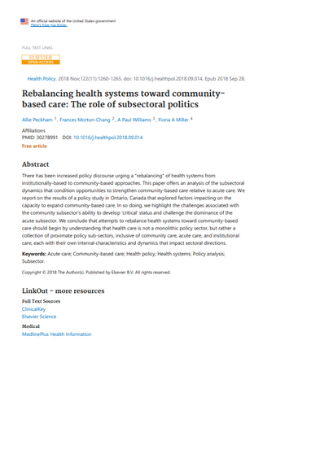Rebalancing health systems toward community-based care: The role of subsectoral politics
Attempts to rebalance health systems towards strengthened community-based care have been relatively unsuccessful. In order for rebalancing efforts to offer any form of staying power there first needs to be an understanding of the complexity of the community subsector to inform the types of inputs necessary to successfully expand community care avoiding further fragmentation and/or maintenance of the status quo.
Author: Allie Peckham, Frances Morton-Chang, A Paul Williams, Fiona A Miller
Publication Date: September 26, 2018
Description: There has been increased policy discourse urging a "rebalancing" of health systems from institutionally-based to community-based approaches. This paper offers an analysis of the subsectoral dynamics that condition opportunities to strengthen community-based care relative to acute care. We report on the results of a policy study in Ontario, Canada that explored factors impacting on the capacity to expand community-based care. In so doing, we highlight the challenges associated with the community subsector's ability to develop 'critical' status and challenge the dominance of the acute subsector. We conclude that attempts to rebalance health systems toward community-based care should begin by understanding that health care is not a monolithic policy sector, but rather a collection of proximate policy sub-sectors, inclusive of community care, acute care, and institutional care, each with their own internal characteristics and dynamics that impact sectoral directions.
Access: Free
Keywords: acute care, community-based care, health policy, health systems, policy analysis, subsector



